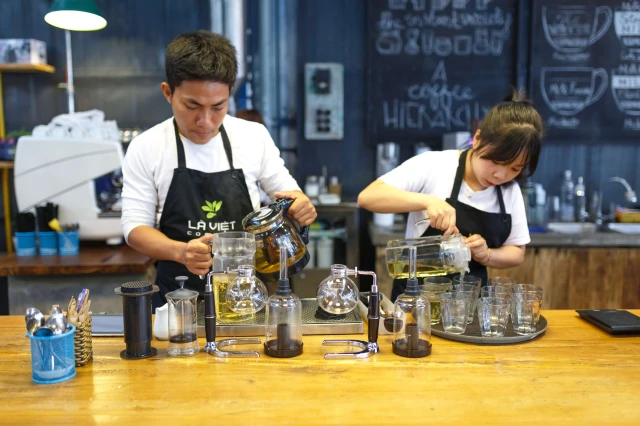Employee management: How restaurants prevent employee burnout with better scheduling
Employee burnout or occupational burnout isn’t something to be taken lightly. Nevertheless, it is a pressing dilemma within the dynamic, demanding foodservice industry, and it clearly is. Physically challenging work, dragged-out hours, and the weighted emotional labour of serving customers all add to burnout.
It is a condition that surpasses just being tired. A long-drawn-out and more serious concern that can be hard for you to spot as an employer. If your employees are experiencing burnout, the following symptoms may show:
- Diminished self-confidence
- Feeling helpless or stuck
- Emotionally drained
- Unmotivated and loss of interest
- Cynical or resentful feelings
As a restaurant owner and employer, what measures can you do to alleviate employee burnout? Read on to find out.
What is an occupational burnout?
It is a kind of job-related stress wherein you’re in a state of emotional or physical fatigue. As a result, you will feel a sense of personal identity loss and reduced accomplishments.
Burnout is not a medical prognosis. According to experts, burnout may be due to other conditions like depression. They also point out that certain individual factors can influence burnout, such as family life and personality traits.
Regardless of what causes it, employee burnout can significantly affect your employees’ mental and physical condition. Therefore, it’s best to consider what you can do about it and how to identify it.
How can you identify burnout?
Surprisingly, you can quickly identify burnout. Insomnia, digestive problems, dizziness, and headaches are physical symptoms. However, you’ll probably know these easy-to-detect symptoms if employees tell you.
Burnout in restaurants has two primary sources—exhaustion and emotional labour.
- Exhaustion
All present-day workers are likely overworked as restaurants are short-staffed right now. Additionally, some staff that were only servers before must add other duties on their plate like food running, hosting, bartending, and even dishwashing.
The work nature of the restaurant industry has been prone to overwork even before the pandemic. Work hours are demanding and lengthy. Shifts are changing as ever, and employees are constantly in haste. This dramatic spike in adrenaline can quickly lead to exhaustion.
- Emotional labour
Part of working in the bustling dynamic of restaurants is that your employees must manage their emotions when interacting with customers and coworkers. Therefore, emotional labour is typical when working in restaurants, particularly in the FOH (front of house).
A rude customer during a busy shift can send any restaurant employee haywire. The long-drawn-out issue of mistreatment from customers to servers and the expectation that FOH staff implement COVID-19 safety measures make burnout unavoidable.

How to prevent employee burnout
Noticing when your employees are starting to feel exhaustive can help you act or bolster positive actions before things spiral out of control. Get in touch with your team managers and ask them to look for increased accidents or mishaps, exhaustion, irritability, and frequent sick time.
Even with just simple tactics, you will be more proactive in fighting work burnout. Ensure your managers and employees know they can discuss what’s happening. Have more wellness-centred programs and schedule regular team meetings to know every location’s status.
- Streamline daily tasks
The moment your employees feel burnout, it can negatively affect other things. For example, there might be errors when doing inventory, or employees might skip essential steps in a closing or opening checklist. For example, instead of doing line checks every time, employees might enter temperatures or refrigerate a particular food rather than discard it.
Make it faster and easier for your workers to do their job. For example, give them a bonus if they are able to complete their tasks accordingly via award interpretation. You can do this by using a digital employee management software like RosterElf.
- Prioritise employees’ wellbeing
Making employees’ wellness your priority is part of being proactive when looking for work burnout. It can excessively eat out your business's profitability, yet anything that can retain employees helps manage labour costs in this hugely competitive market.
Set sick leaves and paid time offs in place, and ensure employees are aware they can take both. Lessen hours temporarily if you can’t fill shifts to ensure employees aren’t spreading themselves too thin.
Make sure your entire workforce knows you appreciate what they are doing and create an emphasise on it. Then, throw in some reward like a gift card or small bonus to show your gratitude.
- Impose break time
Giving your employees and yourself a break is one of the best ways to control burnout. To let go of any built-up tension, enforcing breaks to your team is a must. It is required for employees to take their breaks by the labour standards. However, it is often missed in restaurants, especially by tipped employees, as leaving the floor for a short while will cost them tips.
Whenever the busy shift has calmed down, allow your workers to take turns for a few minutes to rest. Do so for yourself, your managers, and cooks as well. A short 10-15 minutes break can go a long way to boost emotional condition and energy levels.
- Invest in digital schedule and employee management apps
Setting a digital employee scheduling app in place gives you tons of benefits, and one of them is that you no longer have to depend on your manager’s forecast when making employee schedules.
Innovative scheduling software like RosterElf can help your managers optimise staff based on sales forecasts. As a result, it is beneficial with your new managers. What’s more, your employees will love these apps because they can quickly check and manage their shifts remotely.
They do not need to text a colleague to know their work schedule or constantly check with their managers to record a swap shift they requested. Your employees can manage their job and schedule from their phones, which is one effective way to retain good employees.
- Learning must be your ongoing priority
A surge of new employees throws a huge sucker punch in the restaurant industry as many people leave the industry in 2020. Many restaurateurs have lost their highly experienced workers to impart knowledge and skills to new hires. Training is always crucial, especially after the onboarding phase.
Key takeaway
Burnout is a fait accompli in the hustling world of restaurants. But, whether your employees are experiencing it or yourself, you should have ways to counter such a crisis. This guide will help you and your workforce manage burnout.
While you can’t completely eradicate it, as some is a given in any customer-centred setting, monitoring morale is essential. You can do so by reestablishing and reassessing burnout management and prevention. The moment you can spot it, you can indeed manage burnout and prevent it from plunging your business.
RosterElf: Rostering made easy
RosterElf's cloud-based payroll and rostering software truly is a game-changer. Say goodbye to roster conflicts and chase employees for their availability to work. Instead, employees can easily update their availability to work and notify managers about it through a smartphone app.
Staff set the times and days they can work, and RosterElf does the rest. Our software then automatically suggests available employees fill shifts.
What are you waiting for? Time to take your rostering and payroll game to the next level and boost your business' performance. Contact us now, and our team will be more than happy to assist you.
To get a clearer view of how our app works, enjoy 30-day access to our tool for free!



